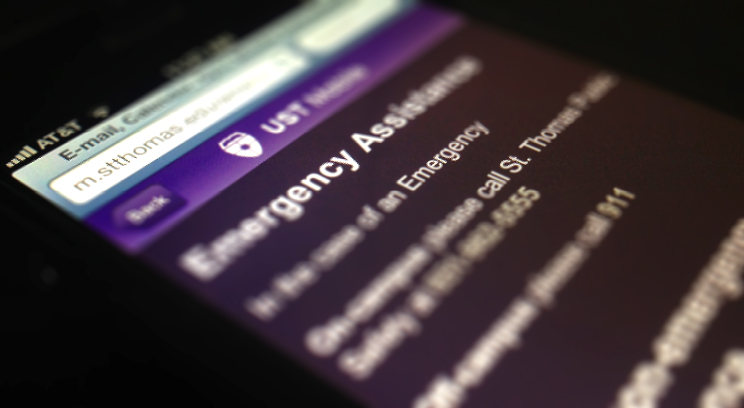The situation
Situation: You are about to step into an elevator when the fire alarm goes off. What should you do?
Situation: You are teaching in an O’Shaughnessy Educational Center classroom and sirens begin to wail, warning of severe weather. What should you do?
Situation: You are in your residence hall room and you hear what sounds like gunfire. What should you do?
When what seemed to be gunshots were reportedly heard near the St. Thomas campus Nov. 16 in downtown Minneapolis, individuals on the university's Minneapolis campus were instructed to “seek shelter and remain in place.” According to Karen Lange, dean of students and co-chair of the University Action and Response Team (UART), it is critical that people are prepared and have the tools they need. Reviewing emergency procedures, discussing your department’s office safety plan, and registering your mobile phone numbers with St. Thomas’ emergency notification system are important in preparing for an emergency on campus.
What should you do?
A good start is to learn and follow the safety tips provided by the Public Safety's quick reference Emergency Guides. When emergencies arise, it’s critical to know what to do. Lives may depend upon your actions. In addition to listing emergency telephone numbers, the guide provides procedures to deal with:
- Active shooters
- Bomb threats and searches
- Criminal activity
- Fire
- Gas leaks, fumes or vapors
- Hazardous material spills
- Medical emergencies
- Severe weather
- Suspicious mail or packages
- Utility failure
The University Action and Response Team (UART) and Public Safety also suggest the following:
USTALERT
Register your mobile phone with USTALERT through Murphy Online. Complete the registration via the "Personal Information" tab.
Sheltering in place
Things happen that are out of our control, so sheltering in place is required. What should you do when an emergency dictates that you shelter in place? Dan Meuwissen, director of public safety, offers the following “sheltering in place” guidelines:
Hazardous material released from fires, explosions or chemical spills, or severe weather conditions, such as a lightning storm, large hail or tornado:
- Go immediately indoors and close all windows and doors.
- For soot/ash from local fires and chemical spills, close off all air from under doors, or wherever air could seep into the room.
- For tornadoes, seek shelter in the lowest, most inner part of the building.
- For floods, move to upper floors.
- Do not leave your shelter until directed so by authorized personnel.
Dangerous situations, such as a person with a gun, bomb or other weapon:
- If the threat is in the area, but not near you:
- Move AWAY from the area of danger, as quickly as possible.
- If the threat is near you and you can escape:
- If you know where the threat is and can move away from it, do so as quickly as possible. Run, if necessary.
- If the threat is near you and you can (safely) lock the door:
- Move into an area in which you can LOCK THE DOOR.
- Turn off the lights and turn off all electronic devices
- Hide behind furniture and be as quiet as possible.
- Wait for an all-clear message or for UST Public Safety to release you from your position.
- Do everything you can to survive until UST Public Safety or police respond.
- When police enter the room, follow their instructions carefully.
* * *
The University Action and Response Team offers this Sheltering in Place Exercise for office, department and classroom discussions.
* * *
Is your office, department or classroom prepared for an emergency? An Office/Department Safety Plan can be viewed here.







